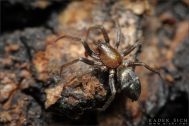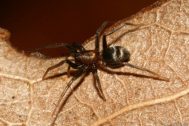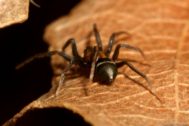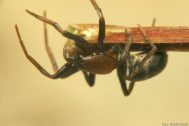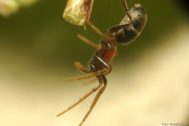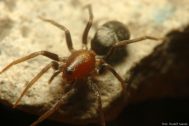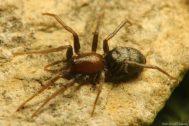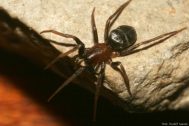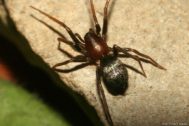| Nálezy podle období | |||||
|---|---|---|---|---|---|
| Gnaphosidae | 0-1900 | 1901-1950 | 1951-2000 | 2001+ | ∑ |
| Micaria sociabilis Kulczyński, 1897 Kriticky ohrožený | 1× | 10× | 11× | ||
Micaria sociabilis Kulczyński, 1897
| České jméno | mikarie pospolitá |
|---|---|
| Stupeň ohrožení | Kriticky ohrožený |
| Nálezy | 11 nálezů, 3 kvadrátů |
| Poslední nález | 2019 , Radek Šich |
| Fytogeografická oblast | - |
| Původnost stanovišť | - |
| Vlhkost stanovišť | - |
| Stratum | - |
| Osvětlení stanovišť | - |
| Hojnost výskytu |
|
| Nadm. výška | 150-150 |
Literatura
Ant-mimicking spider actively selects its mimetic model (Araneae: Gnaphosidae; Hymenoptera: Formicidae).
In visual Batesian mimicry, the mimic acquires protection from predators by imitating visual signals of the model. It has not been known whether the occurrence of mimics among models is a result of selection by predators or an active choice by the mimics. Here, the occurrence of an ant-like spider, Micaria sociabilis Kulczyński, 1897, which occurs on tree trunks and visually imitates arboricolous Liometopum microcephalum (Panzer, 1798) ants, was studied. The fauna of arboricolous ant species was surveyed together with six tree characteristics in order to find which variables determined the occurrence and abundance of Micaria sociabilis. It was found that Micaria sociabilis occurred exclusively on trees where L. microcephalum ants occurred. The effect of any tree variable was not significant. The abundance of Micaria sociabilis increased positively with the abundance of L. microcephalum. Then, experiments using an olfactometer and Y-maze with volatile and contact cues obtained from the two most abundant ant species, L. microcephalum and Lasius fuliginosus(Latreille, 1798), were performed to find whether Micaria preferred any cue. Micaria sociabilis did not respond to volatile cues obtained from the gaster of the two ant species. In contrast, it avoided contact cues from L. fuliginosus and was attracted to contact cues from L. microcephalum ants and its gaster extract in hexane. The results thus show that Micaria sociabilis associates exclusively with L. microcephalum and is attracted to contact cues from this ant while avoiding cues from the competing ant. This study reveals that Batesian mimics may use kairomones to associate with visual models.
Female control of mate plugging in a female-cannibalistic spider (Micaria sociabilis)
Background: Sperm competition imposes a strong selective pressure on males, leading to the evolution of various physiological, morphological and behavioral traits. Sperm competition can be prevented by blocking or impeding the access to female genitalia by means of a mating plug. We investigated the factors responsible for plug production and function in the promiscuous female-cannibalistic spider Micaria sociabilis (Gnaphosidae).
Results: We performed mating trials using females with and without a plug that consists of an amorphous mass. The mating trials demonstrated that the probability of male plugging increased non-linearly with the duration of copulation. Copulation duration and plug production seem to be controlled by the female. We found that females terminated matings later if males were fast at genital coupling. Whereas incomplete plugs had disappeared on the day following copulation, complete plugs persisted (40%). In matings with females with complete plugs, only a small proportion of males (7%) were able to remove the plug, indicating the high effectiveness of plugging. Moreover, males ceased attempts to copulate with plugged females with higher probability. 3D X-ray microscopy of the female and male genitalia showed that the plug material can extend far into the female genital tract and that the plug material is produced by a massive gland inside the palpal organ of the modified male pedipalps.
Conclusions: Our study demonstrates that the mating plug in Micaria sociabilis constitutes an effective male strategy to avoid sperm competition that seems to be under female control.
Keywords: Secretory plugs, Sperm competition, Cryptic female choice, Multiple mating, X-ray microscopy
Mate with the young, kill the old: reversed sexual cannibalism and male mate choice in the spider Micaria sociabilis (Araneae: Gnaphosidae).
Fotografie
Statistiky
Dle měsíce v roce
Dle nadmořské výšky
Dle metody sběru (11 použitých nálezů)
| Micaria sociabilis Kulczyński, 1897 CR | Samci | Samice | Mláďata | Nálezy |
|---|---|---|---|---|
| Neurčeno | 0 | 0 | 0 | 2 |
| Pozorování | 0 | 0 | 0 | 4 |
| Individuální sběr | 3 | 3 | 0 | 5 |
| Samci | Samice | Mláďata | Nálezy |
Dle biotopu (11 použitých nálezů)
| Micaria sociabilis Kulczyński, 1897 CR | Samci | Samice | Mláďata | Nálezy |
|---|---|---|---|---|
| Neurčeno | 2 | 3 | 0 | 6 |
| Lesní okraje | 0 | 0 | 0 | 1 |
| Zahradnicky utvářené zahrady a parky | 1 | 0 | 0 | 4 |
| Samci | Samice | Mláďata | Nálezy |




